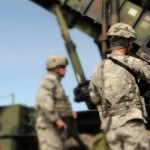Assemble or modify electrical or electronic equipment, such as Frequency Converters, Motor Generators, DC Power Supplies, Distribution panels, Remote Stations, Electrical panels, etc.
Tasks
- Read and interpret schematic drawings, diagrams, blueprints, specifications, work orders, or reports to determine materials requirements or assembly instructions.
- Assemble electrical or electronic systems or support structures and install components, units, subassemblies, or wiring, using electric terminals, bolts, or soldering.
- Adjust, repair, or replace electrical or electronic component parts to correct defects and to ensure conformance to specifications.
- Position, align, or adjust work pieces or electrical parts to facilitate wiring or assembly.
- Explain assembly procedures or techniques to other workers.
- Clean parts, using cleaning solutions, air hoses, and cloths.
- Drill or tap holes in specified equipment locations to mount control units or to provide openings for elements, wiring, or instruments.
- Confer with supervisors or engineers to plan or review work activities or to resolve production problems.
- Inspect or test wiring installations, assemblies, or circuits for resistance factors or for operation and record results.
Tools & Technology
Tools used in this occupation:
| Multimeters — Digital multimeters |
| Screwdrivers — Flathead and Philips head screwdrivers |
| Stripping tools — Wire strippers |
| Crimping tools – Wire terminal crimpers |
| Drills – Both Corded and non-corded drills. |
| Hand tools – wrenches, ratchets and sockets, metal files, etc. |
| Soldering tool – Soldering iron |
Skills
| Reading Comprehension — Understanding written sentences and paragraphs in work related documents. |
| Judgment and Decision Making — Considering the relative costs and benefits of potential actions to choose the most appropriate one. |
| Monitoring — Monitoring/Assessing performance of yourself, make improvements or take corrective action. |
| Active Listening — Giving full attention to what other people are saying, taking time to understand the points being made, asking questions as appropriate, and not interrupting at inappropriate times. |
| Coordination — Adjusting actions in relation to others’ actions. |
| Critical Thinking — Using logic and reasoning to identify the strengths and weaknesses of alternative solutions, conclusions or approaches to problems. |
Abilities
| Near Vision — The ability to see details at close range (within a few feet of the observer). |
| Finger Dexterity — The ability to make precisely coordinated movements of the fingers of one or both hands to grasp, manipulate, or assemble very small objects. |
| Oral Comprehension — The ability to listen to and understand information and ideas presented through spoken words and sentences. |
| Arm-Hand Steadiness — The ability to keep your hand and arm steady while moving your arm or while holding your arm and hand in one position. |
| Manual Dexterity — The ability to quickly move your hand, your hand together with your arm, or your two hands to grasp, manipulate, or assemble objects. |
| Information Ordering — The ability to arrange things or actions in a certain order or pattern, according to a specific rule or set of rules (e.g., patterns of numbers, letters, words, pictures, mathematical operations). |
| Inductive Reasoning — The ability to combine pieces of information to form general rules or conclusions (includes finding a relationship among seemingly unrelated events). |
| Oral Expression — The ability to communicate information and ideas in speaking so others will understand. |
| Visualization — The ability to imagine how something will look after it is moved around or when its parts are moved or rearranged. |
| Written Comprehension — The ability to read and understand information and ideas presented in writing. |
| Lifting – The ability to lift 50 lbs from the floor to table height; approximately 5% of the work shift. |
| Sitting – The ability to sit in one location for an extended period of time; approximately 40% of the work shift. |
| Standing – The ability to stand in one location for an extended period of time; approximately 30% of the work shift. |
| Squatting – The ability to perform assembly work in a squatting position; approximately 20% of the work shift. |
| Climbing – The ability to climb a step ladder to perform tasks that are out of normal reach; approximately 5% of the work shift. |
Work Activities
| Getting Information — Observing, receiving, and otherwise obtaining information from all relevant sources. |
| Making Decisions and Solving Problems — Analyzing information and evaluating results to choose the best solution and solve problems. |
| Evaluating Information to Determine Compliance with Standards — Using relevant information and individual judgment to determine whether events or processes comply with laws, regulations, or standards. |
| Handling and Moving Objects — Using hands and arms in handling, installing, positioning, and moving materials, and manipulating things. |
| Communicating with Supervisors, Peers, or Subordinates — Providing information to supervisors, co-workers, and subordinates by telephone, in written form, e-mail, or in person. |
| Monitor Processes, Materials, or Surroundings — Monitoring and reviewing information from materials, events, or the environment, to detect or assess problems. |
| Inspecting Equipment, Structures, or Material — Inspecting equipment, structures, or materials to identify the cause of errors or other problems or defects. |
| Controlling Machines and Processes — Using either control mechanisms or direct physical activity to operate machines or processes (not including computers or vehicles). |
| Identifying Objects, Actions, and Events — Identifying information by categorizing, estimating, recognizing differences or similarities, and detecting changes in circumstances or events. |
| Organizing, Planning, and Prioritizing Work — Developing specific goals and plans to prioritize, organize, and accomplish your work. |
Work Context
| Indoors, Environmentally Controlled —This job requires working indoors in environmentally controlled conditions the majority of the time. |
| Wear Common Protective or Safety Equipment such as Safety Shoes, Glasses, Gloves, Hearing Protection, and Hard Hats— This job requires wearing safety shoes at all times. |
| Spend Time Using Your Hands to Handle, Control, or Feel Objects, Tools, or Controls — this job require using your hands to handle, control, or feel objects, tools or controls the majority of the time. |
| Time Pressure — This job require the worker to meet strict deadlines. |
| Importance of Being Exact or Accurate —It is very important to be very exact or highly accurate in performing this job. |
| Face-to-Face Discussions — this job often requires face-to-face discussions with individuals or teams in this job. |
| Freedom to Make Decisions —There is some decision making freedom, without supervision, with this job. |
| Spend Time Making Repetitive Motions — this job requires making repetitive motions at different stages of assembly. |
| Work With Work Group or Team —It is very important to work with others in a group or team in this job. |
| Coordinate —It is very important to coordinate in accomplishing work activities in this job. |
Work Styles
| Attention to Detail — Job requires being careful about detail and thorough in completing work tasks. |
| Dependability — Job requires being reliable, responsible, and dependable, and fulfilling obligations. |
| Achievement/Effort — Job requires establishing and maintaining personally challenging achievement goals and exerting effort toward mastering tasks. |
| Cooperation — Job requires being pleasant with others on the job and displaying a good-natured, cooperative attitude. |
| Integrity — Job requires being honest and ethical. |
| Adaptability/Flexibility — Job requires being open to change (positive or negative) and to considerable variety in the workplace. |
| Persistence — Job requires persistence in the face of obstacles. |
| Initiative — Job requires a willingness to take on responsibilities and challenges. |
| Independence — Job requires developing one’s own ways of doing things, guiding oneself with little or no supervision, and depending on oneself to get things done. |
| Stress Tolerance — Job requires accepting criticism and dealing calmly and effectively with high stress situations.
Note: There may be times in which an employee will be expected to assist other departments which may involve tasks outside of this description. |
Environmental
Final assembly area- you will spend 70% of your work shift in the final assembly area of the production floor. (NOTE: There are equipment hazards to be aware of while working in this area: fork truck traffic, overhead crane use, cherry pickers, power tools, etc.)
Sub assembly area – you will spend 30% of your work shift in the sub assembly area of the production floor. (NOTE: There are equipment hazards to be aware of while working in this area; power tools.
You must be alert for hazards at all times!!























